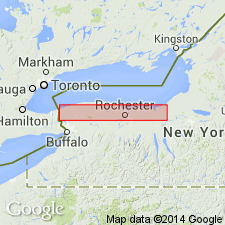
- Usage in publication:
-
- Seneca Park Bed
- Modifications:
-
- Named
- Dominant lithology:
-
- Limestone
- AAPG geologic province:
-
- Appalachian basin
Summary:
Bed at Rochester, NY, at the top of the Brewer Dock Member of the Reynales Limestone, originally referred to as Furnaceville Hematite or Iron Ore by Gillette (1947) is here termed the Seneca Park Bed. This hematitic limestone bed is 20 to 40-cm thick and consists of a fossil-rich ore in which fragments of bryozoans, crinoids, and ostracodes, as well as intraclasts, have been replaced by hematite. Recent study has shown that the bed is equivalent only to the uppermost part of the true Furnaceville Member at its type section in Ontario, Wayne Co., NY. The Furnaceville Member of the Reynales Limestone is the lateral equivalent of the entire Brewer Dock Member. Westward extent of the bed is undetermined, but a core from Albion, Orleans Co., includes a 20-30 cm-thick crinoidal grainstone bed devoid of hematite, 1.0 m above the base of the Reynales. This crinoidal bed has been traced westward to Niagara Gorge. The Seneca Park Bed and its crinoidal equivalent are used in this report to define the top of the Brewer Dock Member. Bed is absent at Glen Edith on the east side of Irondequoit Bay where the overlying Wallington Member lies directly on the lower part of the Brewer Dock Member. Age is Silurian (Llandoverian).
Source: GNU records (USGS DDS-6; Reston GNULEX).
For more information, please contact Nancy Stamm, Geologic Names Committee Secretary.
Asterisk (*) indicates published by U.S. Geological Survey authors.
"No current usage" (†) implies that a name has been abandoned or has fallen into disuse. Former usage and, if known, replacement name given in parentheses ( ).
Slash (/) indicates name conflicts with nomenclatural guidelines (CSN, 1933; ACSN, 1961, 1970; NACSN, 1983, 2005, 2021). May be explained within brackets ([ ]).

